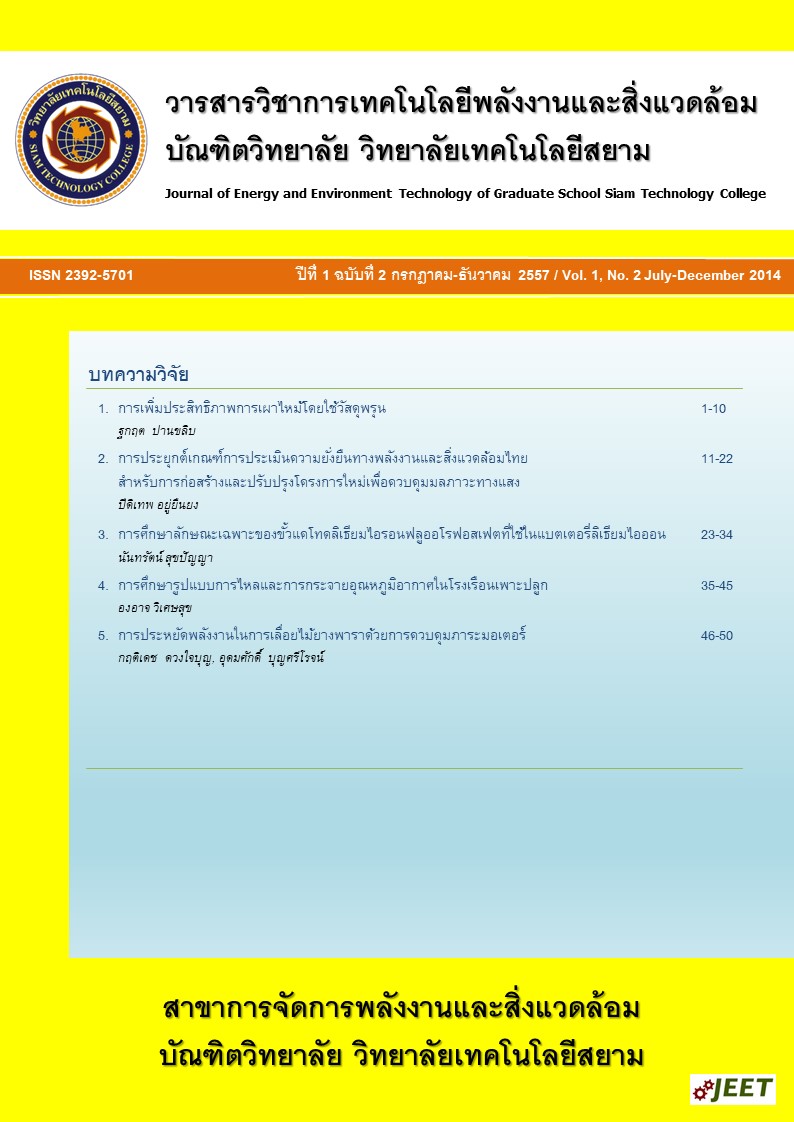Applying TREES-NC Standards to light pollution control
Main Article Content
Abstract
ract
Applying TREES-NC (Thai’s Rating of Energy and Environmental Sustainability for New Construction and Major Renovation) Standards to light pollution control means using the TREES-NC Standards to set light pollution control that deliver improved outcomes for environmentally friendly lighting practices, which provide an environmental experience and deliver benefits for energy saving and the environment. To do this green building designers and engineers need to apply a range of rating systems for lighting consideration.
Applying TREES-NC guidance, and in particular TREES-NC illuminating engineering and lighting design guidance, should be the starting point for green building stakeholders looking to ensure their lighting practices get the environmental lighting standardisation that best meets TREES-NC’s criteria. TREES-NC guidance is seen as the national green building standard setter for effective urban light pollution prevention.
Article Details
เนื้อหาและข่อมูลในบทความที่ลงตีพิมพ์ในวารสารวิชาการ เทคโนโลยี พลังงาน และสิ่งแวดล้อม บัณฑิตวิทยาลัย วิทยาลัยเทคโนโลยีสยาม ถือเป็นข้อคิดเห็นและความรับผิดชอบของผู้เขียนบทความโดยตรง ซึ่งกองบรรณาธิการวารสารไม่จำเป็นต้องเห็นด้วย หรือว่าร่วมรับผิดชอบใด ๆ
บทความ ข้อมูล เนื้อหา รูปภาพ ฯลฯ ที่ได้รับการตีพิมพ์ในวารสารวิชาการ เทคโนโลยี พลังงาน และสิ่งแวดล้อม บัณฑิตวิทยาลัย วิทยาลัยเทคโนโลยีสยาม ถือเป็นลิขสิทธิ์ของวารสารวิชาการ เทคโนโลยี พลังงาน และสิ่งแวดล้อม บัณฑิตวิทยาลัย วิทยาลัยเทคโนโลยีสยาม หากบุคคล หรือหน่วยงานใดต้องการนำทั้งหมด หรือส่วนหนึ่งส่วนใดไปเผยแพร่ต่อ หรือเพื่อกระทำการใด ๆ จะต้องได้รับอนุญาต เป็นลายลักษณ์อักษรจากวารสารวิชาการ เทคโนโลยี พลังงาน และสิ่งแวดล้อม บัณฑิตวิทยาลัย วิทยาลัยเทคโนโลยีสยาม เท่านั้น
References
[2] สถาบันอาคารเขียว. (2553). คำถามที่ถูกถามบ่อย (TREES-NC). กรุงเทพฯ: สถาบันอาคารเขียว.
[3] California Building Standards Commission. (2010). Guide to the (Non-Residential) California Green Building Standards Code. (2nd edition). Sacramento: California Building Standards Commission.
[4] Concerted Action Energy Performance of Buildings. (2011). Implementing the Energy Performance of Building Directive (EPBD): Featuring Country Reports 2010. Brussels: European Commission's Intelligent Energy Europe.
[5] Cotten, M. N. (2012). The Wisdom of LEED's Role in Green Building Mandates. Cornell Real Estate Review. 10 (6), pp 22-37.
[6] Department for Communities and Local Government. (2006). Code for Sustainable Homes: A step-change in sustainable home building practice. London: Department for Communities and Local Government
[7] Fowler, K. M. & Rauch, E. M. (2006). Sustainable Building Rating Systems Summary. Richland: Pacific Northwest National Laboratory & U.S. Department of Energy.
[8] Kardel, S. W. (2012). Rethinking how we light at night: cutting light pollution for more sustainable nights. Journal of Green Building. 2012 7 (3), pp. 3-15.
[9] Rönn, M. (2008). The importance of lighting to the experience of architecture - the lighting approach in architectural competitions. Stockholm: KTH Royal Institute of Technology.
[10] Sleeuw, M. (2011). A Comparison of BREEAM and LEED Environmental Assessment Methods: A Report to the University of East Anglia Estates and Buildings Division. Norwich: University of East Anglia Low Carbon Innovation Centre.
[11] UK Green Building Council. (2009). Making the case for a Code for Sustainable Buildings. London: UK Green Building Council.
[12] U.S. Green Building Council. (2008). LEED 2009 for New Construction and Major Renovations Rating System. Washington, DC: U.S. Green Building Council.
[13] U.S. House of Representatives. (2014). H. Rept. 113-371 - BETTER BUILDINGS ACT OF 2014 - 113th Congress (2013-2014) February 28, 2014, As Reported by the Energy and Commerce Committee. Washington, DC: U.S. House of Representatives.
[14] Vermont Housing Finance Agency. (2012). Green Building and Design Standards May 2012. Burlington: Vermont Housing Finance Agency.
[15] Welch, A. et al. (2011). A Citizen’s Guide to LEED for Neighborhood Development: How to Tell if Development is Smart and Green. New York: Natural Resources Defense Council.


